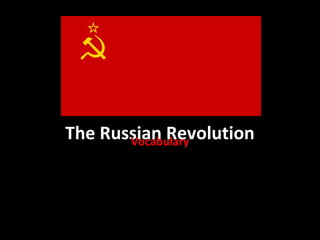
Russian Revolution Vocabulary
- 1. The Russian Revolution Vocabulary
- 3. Volga Barge Haulers, Ilya Pepin (1873) 1. Describe this painting. Who are these people? What must their life be like?
- 4. 2. Describe this photo. Who are these people? What must their life be like? Tsar Nicholas and his wife Alexandra also had five children: Olga, Tatiana, Maria, Alexei, and Anastasia.
- 5. Identify these people. How do they relate to the Russian Revolution?
- 6. Creation of the Soviet Union Tsar abdicates Duma Start of WWI February Revolution Bloody Sunday Provisional Government Russo-Japanese War Revolution of 1905 Treaty of Brest-Litovsk October Revolution Start of Civil War
- 7. Russian Revolution Timeline 1. Russo-Japanese War - 1904 2. Bloody Sunday - January 1905 3. Revolution of 1905 4. Creation of the Duma – 1906 5. Start of WWI – 1914 6. February Revolution – 1917 7. Tsar Abdicates – March 1917 8. Provisional Government – March 1917 9. October Revolution – 1917 10. Civil War – 1917 to 1922 11. Treaty of Brest-Litovsk – March 1918 12. Creation of the Soviet Union – December 1922
- 8. Tsar Nicholas II The last ruler of Russia. After more than 300 years, Nicholas was the last of the Romanov royal family to rule. Karl Marx German philosopher who developed the theory of communism. Communism is a theory that imagines a classless, egalitarian society.
- 9. Provisional Government The temporary government that led Russia after the Tsar abdicated. The provisional government was short- lived, lasting only eight months until it was taken over by the Bolsheviks. Treaty of Brest-Litovsk The Treaty of Brest-Litovsk was a peace treaty signed on March 3, 1918, between Russia and the Central Powers, leading to Russia's exit from World War I. While the treaty was practically obsolete before the end of the year, it gave some break to Bolsheviks waging the civil war in all directions and contributed to the independence of Finland, Estonia, Latvia, Lithuania and Poland.
- 10. Proletariat The working class. The class of wage earners, especially those who earn their living by manual labor. Bourgeoisie The wealthy, upper classes.
- 11. Vladimir Lenin Russian founder of the Bolshevik Party (communists), leader of the Russian Revolution (1917), and first head of the USSR (1917-1924). Bolsheviks The Russian communist party. The Bolsheviks took control of Russia, renaming it The Soviet Union. The Bolsheviks believed in give power and control to the peasants and workers (i.e., the “Proletariat”). Lenin campaigned for the Bolsheviks with the slogan, “peace, land, and bread.”
- 12. Leon Trotsky A leader of the Bolshevik Revolution (1917), he was later expelled from the Communist Party (1927) and banished (1929) for his opposition to Stalin and his emphasis on world revolution. Joseph Stalin Leader of the Soviet Union following Lenin’s death (1924–53). Stalin is responsible for the deaths of millions of Russians. Through starvation, executions, imprisonment, and disappearances.
- 13. NKVD > KGB The secret police of the Soviet Union. The secret police went after “enemies of the state”, real or perceived, creating a police state based on terror. Gulags Forced labor camps. “Enemies of the state” were sent to Gulags were they worked as slave laborers building dams, canals, roads, and other infrastructure.
- 14. The three colors purportedly came from the coat of arms of the Grand Duchy of Moscow, which depict Saint George wearing white (silver) armor, riding a white horse, wearing a blue cape and holding a blue shield, on a red field. According to another version, these three colors were associated with the robes of the Virgin Mary, the holy protectress of Russia. Yet another interpretation of the three colors is the order that they are placed reflected the Russian social system while under the monarchy: white represents God, blue represents the Tsar and red represents the peasants. A different interpretation associates white with the bright future (where the color itself is associated with brightness, while its placement at the top - with future); blue with clouded present, and red with bloody past.
- 15. The newly adopted official flag of the Soviet Union consisted of a plain red flag, with a hammer crossed with a sickle and a red star in the upper hoist. The hammer symbolized the nation's industrial workers, while the sickle symbolized the nation's agricultural workers. The red star represented the rule of the Communist Party.
Notas do Editor
- Catherine’s palace. Summer residence of the Romanovs
- Nikolai Yezhov, the young man walking with Stalin in the top photo from the 1930s, was shot in 1940. Following his death, Yezhov was edited out by Soviet censors.[25] Such retouching was a common occurrence during Stalin's rule.